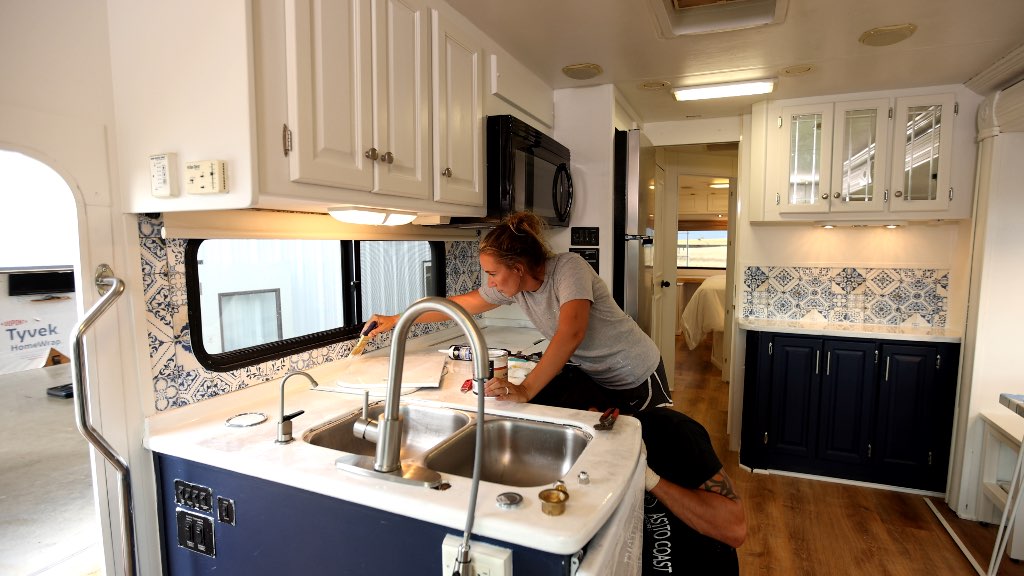Tech Q&A – March 2023
Auxiliary Braking, Winterizing Tips, a Plug and Coil Issue, and an Amperage Upgrade
Image Caption:
Dinghy Braking
Q: We have a 2014 Itasca Suncruiser 37F on a Ford F-53 chassis with a V-10 and tow a 2004 Jeep Liberty 4×4. I understand from the dealer that once I put the Blue Ox baseplate towing system on the Jeep, it does not require a braking system because the Jeep is not considered heavy. What is your opinion as to whether one is needed or not?
—Patrick Sprinkle, Prescott Valley, Arizona
A: An auxiliary braking system is definitely needed, and you need to talk to a different dealer who knows the laws in his or her state. Arizona law requires brakes on towed vehicles weighing over 3,000 pounds, and your Jeep weighs around 4,300 pounds or so.
Most states have similar laws, and if you install an auxiliary braking system that works properly, you’ll be in compliance across the US and Canada. It is very irresponsible of the dealer to make a false statement like that, and you should call them on it. The owner of the dealer should know what is being told to customers is both illegal and dangerous.
Even if it’s not strictly required by law in every state, an auxiliary braking system is an important safety feature that you must have.
I also suggest checking the operation of the braking system after installation. If the dealer can’t be honest with you about needing the brake system in the first place, I would not trust its mechanics to do a proper installation without your own close inspection later.
Use an inexpensive handheld infrared thermometer to check brake temperatures after descending some long hills. Compare brake temperatures at all corners of both vehicles. The temperatures should be fairly similar; very hot or cold brakes indicate problems.
Winterizing RV Problem
Q: We have a 2022 Grand Design Reflection 337RLS fifth-wheel that we bought in August of 2021. It has a universal docking station plumbing system with the Furrion tankless water heater. Before I winterized the RV I read both the owner’s manual and viewed a video online from Grand Design that is recommended for winterizing the water heater and water system using compressed air to vacate water from the plumbing.
After doing this, an option was to siphon RV antifreeze and pump it throughout the waterlines. I tried to do this, but the pump (although it was working) didn’t pump antifreeze. I removed the access panel to the pump and saw a waterline connected to the pump completely flat going to the docking valve system. I then used the air method three more times to clear any water in the system for the winter.
Any ideas on what had happened and suggestions to correct this problem will be greatly appreciated.
—David and Sally, Duluth, Minnesota
A: So the suction side hose on the pump was flat? Did it stay that way, was it hardened or collapsed? It sounds like the pump sucked it together, which shouldn’t happen with such a new vehicle. This would prevent the flow of the antifreeze. Can you replace that section of hose? This should be covered under warranty if you want to spend the time taking it in.
Winterizing an RV
Q: We have a 1999 Fleetwood Prowler travel trailer. When winterizing it, I blow out the lines and then siphon a little antifreeze to protect the water pump. The two times I tried to siphon this year, I couldn’t get it to pump out of the jug. I have a small brass valve that switches from drawing out of the freshwater tank or from the small siphon hose.
The only way I can get the pump to draw the antifreeze is if I rotate the valve to about 45 degrees or so. I never had to do that in the past. I’m concerned that when I do this, it’s going to draw a little of the residual water from the freshwater tank. Any thoughts or suggestions? Is the valve defective?
—Rick Petzak, Zeeland, Michigan
A: Try bypassing the valve, temporarily taking it out of the system for testing purposes. Once it’s removed, try blowing through it by mouth, trying the different settings to determine if it flows properly. If not, replace it with a new one.
Ford V-10 Spark Plug and Coil Issue
Q: I have a 2016 Thor FE27 with a V-10 Ford engine that has 40,000 miles of highway driving (occasional max of 65–70 mph). On a recent short trip, the engine began to run very roughly. Luckily, I was 20 miles from a Ford dealer that serviced RVs, and they made room to take care of us the next day and they also provided free rides to and from the local hotel.
The problem was a failed #4 coil that sits on top of a 6-inch wire that connects to the spark plug. Nothing like the good old days with a distributor and a simple connection to the spark plug.
Also, it was discovered that the specific #4 plug was shot, but also that three other plugs were also showing signs of “abuse.” The offending coil and three plugs were all replaced (at a cost of $900). I can assure you that this RV is my “baby” and that it gets routine service and doesn’t even know the word abuse.
After this little episode, we took a 5,000-mile trip to Canada, and our motorhome only got 8 mpg, not the 10-plus mpg that I’m accustomed to.
Back home, I talked to my Ford service rep. He told me that I should change all the other plugs ($17 each), PLUS the other nine coils (at a cost of $97 each), and it would get the 10 mpg.
I did a little research and learned that these coils have an expected life of about 100,000 miles but that they can be compromised if they become covered with oil or water. Apparently, coils #4 and #5 in these engines have a habit of experiencing a short life because of their proximity to the A/C system (dripping water?).
I’m thinking about replacing the other six spark plugs and coil #5. I’ll keep the old coil #5 as a spare. I can’t see the necessity of replacing all coils because one went bad.
—Wayne Locke, The Villages, Florida
A: This kind of story is very upsetting to me because it’s a glaring example of how some service shops take advantage of their customers and provide false or questionable information. I recommend that all owners carry an OBD-II code reader with them so they can quickly get an idea of what is wrong. There are trouble codes for each cylinder, and misfiring coils can be readily identified and replaced. Most auto parts stores have coils in stock, and many people replace them right in the parking lot.
I did a quick perusal on eBay and an “expensive” complete set of Motorcraft spark plugs and coils was $355, while other brands could be had for $112 for all. Denso is the OEM supplier to Motorcraft for the coil-on plugs (COP). You can get the Denso COP from rockauto.com for $38-ish each, which will save you money while getting quality parts.
The ignition coils should last far longer than 40,000 miles. A few die early, but I have a friend with 450,000 miles on his V-10 vehicle, and most of the coils are original. Ford would not design coil locations with dripping water causing failures, and I can’t find any reference to such a problem. The air-conditioner evaporator core condensation drains under the vehicle, not onto the engine coils.
The Ford service interval on V-10 spark plugs is 60,000 miles. There is no way that driving around Florida’s flat roads could be considered abuse. You should have demanded to see the spark plugs and inspected the tips for condition. If the engine is running well with no trouble codes, I would continue driving it and change the plugs at 60,000 miles.
Where you live in Florida, the roads are flat and produce ideal mileage such as the 10 mpg you report. It’s likely that your trip to Canada included some hills and winds, which reduced the mileage, and 8 mpg is actually more typical for your kind of motorhome.
Upgrade from 30-Amp to 50-Amp
Q: We have a 2017 Forest River Sunseeker Class C motorhome. After reading your response in the February 2022 issue about being able to upgrade from 30 to 50 amps, we were psyched!
First, I called my local Camping World, who told me they had never done it and would not do it. Then I called my local dealer, who first said they could do it in a day for about $3,000. But soon after setting up the appointment, they called us and said that Forest River didn’t recommend doing it, and then said after further review, they could do it, but it would take a week and cost $10,000.
I would still love to have it done and would be willing to pay up to $3,000 if you could tell me where to go based on your research that led to your answer.
—Jimmy Lynch, Smithtown, New York
A: I suggest trying to stay with the 30-amp system you have whenever possible. I’m not recommending the changeover, but just answering your question, which may also be of interest to other readers. With only one air conditioner, you should be able to get along fine on 30-amp service. If you upgrade to 50-amp service, you may find that some campgrounds either don’t have any 50-amp hookups or they are in limited supply, and you will be forced to use a plug adapter, which limits capacity.
A changeover requires a number of parts. You’ll need a 50-amp power cord, which could run close to $300, depending on brand and length. You’ll also need a new power panel, again, several hundred bucks. Generator transfer switches also come in different configurations, and you’ll need to change over; another, starting at about $150.
I spoke at length with Eric Davis, owner of Eric’s RV in Sequim, Washington, and he agreed with me that it should take about 4–6 labor hours to do the changeover. At a shop rate of $150 per hour, that works out to around $600–$900 labor, depending on labor rates. So you should be able to get it done for in the neighborhood of $1,500 or less, and if you use good used parts from an RV Salvage yard, you could save a bundle. I’d love to see how that shop can justify $10,000.
Toilet-Bowl-Seal Conditioner
Q: My 2016 Tiffin Open Road Class A motorhome is stored in a closed garage when not in use. What can I do to keep the toilet seal in good shape, so water stays in the bowl? I run water through all the plumbing weekly to keep the lines flushed and in use, including flushing the toilet and adding a few inches of water. I’ve had to replace this seal almost every year. The current seal is only eight months old, and it’s leaking. Any helpful suggestions?
—Mike Theis, via email
A: You may be giving your coach a little more attention than it needs, but I don’t think you are harming it. Thetford Toilet Seal Lubricant and Conditioner is said to extend the life of a toilet seal and keep it operating smoothly. Its silicone-based formula is reported to be safe on toilets and holding-tank seals, whereas petroleum-based lubricants may cause swelling and degradation of rubber seals. It is available in a 24-ounce bottle and sold at many RV dealers, including Camping World.
Winter Camping Concern
Q: I have a 2021 Keystone Springdale 242RKWE 28-foot travel trailer. Regarding travel trailer camping, there seems to be ample advice available for summer camping and for winterization, but there is a paucity of information on winter camping, except for specially designed units such as those used for ice fishing.
We live in Idaho, where freezing weather is the norm in the winter. Leaving home usually involves at least one overnight in freezing conditions before we enter a warm zone in the south. And there are many options here where we could enjoy an extended stay in winter conditions if we could do so without damage to our unit.
We can carry adequate freshwater in jugs for cooking and drinking and can use that freshwater for flushing the toilet. However, there seem to be no good options for keeping the waste tanks from freezing. Yes, we could use lots (lots!) of the expensive antifreeze, but even that is questionable at best.
I tested the pink stuff in the freezer at a 1:1 dilution with water, and it froze hard. Marine-style porta-potties would overflow quickly. How do winter campers avoid freezing waste tanks? Or is our only option to let it freeze and dump when thawed, hoping that will not damage the tanks and their drains?
—Dick Lowman, Emmett, Idaho
A: I can see you have given this a lot of thought. Fortunately, there is a fairly simple solution: add-on electric heating for existing holding tanks. UltraHeat offers a selection of different size heating pads that attach to the tanks. They’re available in both 120-volt and 12-volt versions, depending on whether you will have access to campground power or not. If you don’t have a plug-in, keep an eye on the battery draw. You should have a generator with you.
OBD-II Plug Location
Q: We have a 1997 Fleetwood Bounder U 35-foot Class A motorhome with a Ford F-53 chassis. The check engine light comes on while driving. I have a code reader. Where is the data link connector plug-in located?
—Ron Foiles, Colorado Springs, Colorado
A: Most of these models have the OBD-II data connector tucked in among the wiring under the driver’s side dash, up above the brake pedal. Sometimes you have to dig around a bit.
Rader Tip: Tankless Water Heater Fix
Regarding Mr. Forrest’s problem with his Thor Windsport motorhome’s tankless heater cycling while showering (December 2022 issue), I have a 2022 Thor Miramar 34.6 motorhome with the tankless system. The problem is too-low flow through the heater, which causes cycling.
I figured out that if I turn on the lavatory faucet, that flow, along with the showerhead, is enough flow to prevent heater cycling. This wastes a lot of water, but at least I get a warm shower. This is the only problem I have encountered with this coach. As my fifth motorhome, this is the best by far. —
—Robert Meadows Conroe, Texas
Thanks for sharing your solution; I’m sure folks will find it helpful. Let me add that most RVs have restrictive water-saving showerheads, and if you change that to one with a somewhat higher flow you may get a nicer shower and not have to waste water uselessly down the sink drain.
Have a Question?
Looking for answers on all things RV, including systems, engines, accessories, or construction? Submit it to our expert at [email protected] and it may be selected for publication. You must include your name, city and state, phone number (will not be published), and type and model of your RV.





